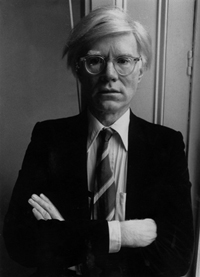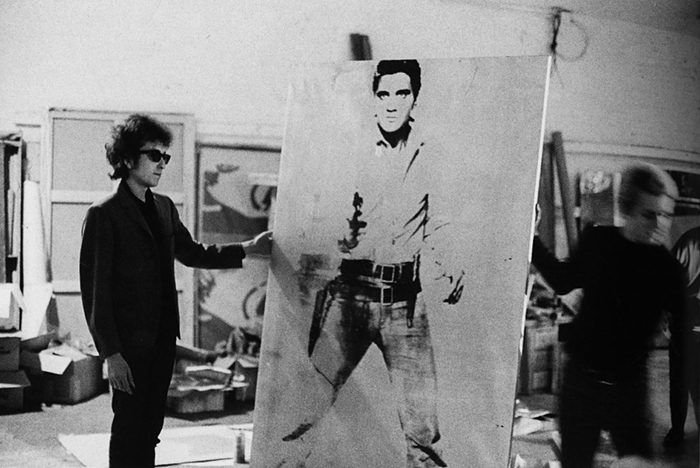 Born in 1928 in Pittsburgh to a pair of Slovakian immigrants, Andy Warhol was a controversial artist who became a leader in the pop art movement. Known for his painting, printmaking, photography, persona, film, and music, Warhol introduced a new paradigm to art culture. He pioneered in something like experimental artistic entrepreneurialism, which, among others, derived from his outsider status and ability to perceive without preconception. His art includes some of the most expensive pieces ever sold; a 1963 canvas of his Eight Elvises sold for $100 million. Over the course of his career, the man became an incredibly successful commercial artist, made over 60 films, produced the Velvet Underground, was shot, and made a mark on culture that has wide-ranging influence today. He died in 1987.
Born in 1928 in Pittsburgh to a pair of Slovakian immigrants, Andy Warhol was a controversial artist who became a leader in the pop art movement. Known for his painting, printmaking, photography, persona, film, and music, Warhol introduced a new paradigm to art culture. He pioneered in something like experimental artistic entrepreneurialism, which, among others, derived from his outsider status and ability to perceive without preconception. His art includes some of the most expensive pieces ever sold; a 1963 canvas of his Eight Elvises sold for $100 million. Over the course of his career, the man became an incredibly successful commercial artist, made over 60 films, produced the Velvet Underground, was shot, and made a mark on culture that has wide-ranging influence today. He died in 1987.
With bad skin, subpar social skills and an interminably poor immune system that often left him bedridden as a child, Andy Warhol's fringe/outsider status was pretty much fated from the beginning. But at 21, he had already earned a degree in graphic design and was an early adopter of printmaking, which allowed him to quickly become a successful commercial artist with a respectable portfolio.
Warhol made his art scene debut in the early 1960s with his Marilyn Diptych, Campbell's Soup cans, prints of money, and Coke bottles. This work was one of the first instances of one of the most important contributions Warhol would make to art culture: a dynamic definition of art. One of Andy's central messages with his debut work was that he didn’t care about the standard conception of art.
All his work that followed his breakthrough served this premise. What even is art? Examples: his Rorschach inkblots, “piss paintings,” and film. Every one of these works -- which are some of his most famous -- forced its audience to question if what they were looking at was even art at all. And when you're in front of a painting, wondering if it's a work of art, it's a very small step to begin questioning the legitimacy of your definition of art, as well as what you think is good and bad art.

Jean-Michel Basquiat (c. 1982), acrylic, silkscreen ink, and urine on canvas
In the mid 60s, Andy pushed another artistic product that forced its audience to understand the definition of art as dynamic when he famously paired with the Velvet Underground as its producer. Formed by Welsh musician John Cale and American singer/songwriter Lou Reed, the group was wildly experimental in its approach to form and composition. Provocative lyrics, spoken word, the use of extended drones, and noisefests all characterized their sound. Warhol contributed to the project by not only “producing” their albums (paid for studio time), but acting as a prod, mentor, agent, and art director.
Warhol's preconceptionless views extended beyond (what would be typically thought of as) his artistic projects. His entire way of being was pretty much one of the first post-modern personalities to gain widespread attention. Throughout his career, he’d make statements like “I am a deeply superficial person” and “I want to be plastic.” He’d essentially refuse to explain his art to interviewers by often giving them one-word answers (“Um, yes,” “Um, no”). When asked about his sexuality, he revealed that he was a virgin -- that he had only had sex in an "abstract sense." At the premiere of his 1964 film Empire, an eight-hour film of continuous slow-motion footage of the Empire State Building, he walked out after 15 minutes, stating that it was too boring to sit through. Once, when asked by an interviewer to respond to criticims that his art was without substance, too-easy, basically borrowed from advertising and mass culture, Warhol responded that he had no answer -- that the critics were absolutely right.
Perhaps what most directly reflects Warhol’s experimental persona is one of its most famous fruits -- The Factory, his studio between 1962 and 1984, and basically the hub of the world he created. Anything went at The Factory -- free love, freaks, and a general attitude of noir subversiveness were the norm. The boundaries of drug use, gender, and sexuality were always under question here. To put it in a more familiar sense: if you ended up at The Factory, you’d definitely see some stuff that -- like most of Warhol's art -- would make you a little uncomfortable with your own preconceived notions of good and bad, right and wrong, appropriate and inappropriate.

Bob Dylan holding a Double Elvis print at The Factory
Our natural instinct -- our default setting -- is to judge art in a literally self-centered way: I don't like this, so it's bad. But I like this one, so it's good. Our default setting puts us, our own individual experience, in the literal center of the universe. It makes our opinions and our perspective the most important in our proximate reality. Our natural instinct often fails to consider the possibility that there isn’t any objective good and bad, any objective definition of art. Which, by definition, is a close-minded attitude that I’m not sure contributes much positivity to the world. But Warhol and his associates took the opposite view: when it came to art and being, nothing was automatically off the table. And so to me their most important contribution to culture was to introduce a way of living that forced people to drop their preconceptions and articulate that they actually didn’t know what art was, couldn't authoritatively say how a person should be. Which is essentially an exercise in open-mindedness. And most people would agree that this is a good thing.






















Awesome post, Brandon, Thanks. http://www.youtube.com/watch?v=Isl-5L0Jf5M